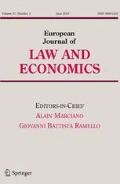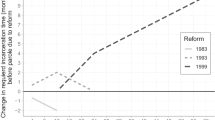Abstract
This article explores the main determinants of the hazard of recidivism among ex-prisoners. We use a nationally-representative sample of prisoners released in 1996–1997 in France, drawn from a 5-year follow-up survey run by the French correctional administration. We estimate semi-parametric duration models which deal with violations of the proportional hazards assumption. Our results confirm the importance of gender, age, nationality, employment status and prior convictions on recidivism within 5 years after release from prison. We also find significant differences in hazards of recidivism by type of initial offense, penal status at entry, and type of release (early release under parole, etc.), while controlling for prison fixed effects. Finally, our study casts doubt on the influence of several sociodemographic variables (marital status at entry, education, homelessness) and on the effectiveness of semi-liberté as a way to prevent recidivism.


Similar content being viewed by others
Notes
Official monthly statistics can be obtained at www.justice.gouv.fr/prison-et-reinsertion-10036/les-chiffres-clefs-10041/statistiques-mensuelles-de-la-population-detenue-et-ecrouee-24982.html.
In this study, the term “recidivism” only stands for “re-conviction”, i.e. the fact that an ex-prisoner commits a new offense and is re-convicted after release.
See Svensson et al. (2013) for an empirical study of the role of moral values, anticipated shame and guilt on juvenile delinquency in the Netherlands.
See Zamble and Quinsey (1997).
See Kubrin and Stewart (2006) for the first empirical investigation on the subject.
See Manski (2000)’s classification of social interactions.
While attractive, these methods necessitate very long follow-up periods (a decade or more) to distinguish those who are at risk (called persisters) from those who would never recidivate (desisters). Therefore most follow-up surveys do not allow for the use of such methods.
653 criminal records could not be retrieved or used for one of the following reasons: un-matched identity, deceased, incomplete record, recording error. One record was not used because it reflected a very special case of incarceration (“contrainte par corps”).
See Kensey and Tournier (2002) for a detailed summary of time served among this sample.
These two French legal measures allow a prisoner to go out of prison routinely for several hours or days to do a particular activity, such as working.
When one is convicted for multiple offenses, the category of the most serious crime is used.
The hazard function is smoothed with Epanechnikov’s alternative kernel function.
The causal effect of time served on recidivism is a very debated theoretical and empirical topic. This article does not address this difficult question, but it is important to control for time served in recidivism studies.
The results of these tests are available in Table 3 in the "Appendix".
The log function implies that the effect of an explanatory variable changes over time in a non-linear way, which seems more realistic than a linear function. However, Table 5 in "Appendix" shows the results we obtained with \(f(t) = t\) and \(f(t) = \sqrt{t}\).
See for example Box-Steffensmeier (2004) for more details on this method. Noteworthy is the fact that this approach leads to very similar results to those obtained with a Generalized Weibull model, when the time dependency parameter \(p\) is a function of the variables \(Z\).
Hazard ratios are obtained by computing \(exp(\hat{\beta })\).
Because \(exp(\frac{\hat{\beta }_{gender}}{\hat{\theta }_{gender}}) = exp(\frac{\ln {0.309}}{\ln {1.333}}) = 57\) days.
This figure is obtained as follows: \(\frac{\hat{h}_{age=30}}{\hat{h}_{age=20}} = \frac{exp(30 \cdot \hat{\beta }_{age} + 30^2 \cdot \hat{\beta }_{age^2})}{exp(20 \cdot \hat{\beta }_{age} + 20^2 \cdot \hat{\beta }_{age^2})} = 0.54\).
For a discussion of the causal effect of time served, see Sect. 2.
In France, parolees are supervised by probation officers after release, for a period equal (at least) to the remainder of their prison sentence.
There is selection bias if parolees (treatment group) differ significantly from the others (control group) in terms of unobservable characteristics that affect the probability of being released under parole (such as motivation, reentry prospects, etc.).
Semi-liberté and placement à l’extérieur both allow prisoners to leave prison during day hours or several consecutive days to achieve a particular task (such as work or training). The different results between these two measures may be due to the fact that placement à l’extérieur is much more selective (2 vs 8 % of the sample) and that it generally allows longer out-of-prison spells.
References
Amirault, J., & Lussier, P. (2011). Population heterogeneity, state dependence and sexual offender recidivism: The aging process and the lost predictive impact of prior criminal charges over time. Journal of Criminal Justice, 39(4), 344–354.
Barlow, H., & Kauzlarich, D. (2010). Explaining crime: A primer in criminological theory., G-reference, information and interdisciplinary subjects series Lanham: Rowman & Littlefield.
Bayer, P., Hjalmarsson, R., & Pozen, D. (2009). Building criminal capital behind bars: Peer effects in juvenile corrections. The Quarterly Journal of Economics, 124(1), 105–147.
Becker, G. S. (1968). Crime and punishment: An economic approach. Journal of Political Economy, 76, 169.
Bernburg, J. G., Krohn, M. D., & Rivera, C. J. (2006). Official labeling, criminal embeddedness, and subsequent delinquency: A longitudinal test of labeling theory. Journal of Research in Crime and Delinquency, 43(1), 67–88.
Bierens, H. J., & Carvalho, J. R. (2002). A competing risk analysis of recidivism. Working paper.
Bierie, D. (2009). Cost matters: A randomized experiment comparing recidivism between two styles of prisons. Journal of Experimental Criminology, 5, 371–397.
Bowles, R. A., & Florackis, C. (2007). Duration of the time to reconviction: Evidence from UK prisoner discharge data. Journal of Criminal Justice, 35(4), 365–378.
Box-Steffensmeier, J. M., & Jones, B. S. (2004). Event history modeling: A guide for social scientists. New York: Cambridge University Press.
Chen, M. K., & Shapiro, J. M. (2007). Do harsher prison conditions reduce recidivism? A discontinuity-based approach. American Law and Economics Review, 9(1), 1–29.
DeAngelo, G., & Charness, G. (2012). Deterrence, expected cost, uncertainty and voting: Experimental evidence. Journal of Risk and Uncertainty, 44, 73–100.
Di Tella, R., & Schargrodsky, E. (2013). Criminal recidivism after prison and electronic monitoring. Journal of Political Economy, 121(1), 28–73.
Drago, F., & Galbiati, R. (2012). Indirect effects of a policy altering criminal behavior: Evidence from the Italian prison experiment. American Economic Journal: Applied Economics, 4(2), 199–218.
Drago, F., Galbiati, R., & Vertova, P. (2009). The deterrent effects of prison: Evidence from a natural experiment. Journal of Political Economy, 117(2), 257–280.
Drago, F., Galbiati, R., & Vertova, P. (2011). Prison conditions and recidivism. American Law and Economics Review, 13(1), 103–130.
Duwe, G., & Clark, V. (2013). Blessed be the social tie that binds: The effects of prison visitation on offender recidivism. Criminal Justice Policy Review, 24(3), 271–296.
Escarela, G., Francis, B., & Soothill, K. (2000). Competing risks, persistence and desistance in analyzing recidivism. Journal of Quantitative Criminology, 16(4), 385–414.
Farrington, D. P. (2003). British randomized experiments on crime and justice. The Annals of the American Academy of Political and Social Science, 589(1), 150–167.
Folkard, M. S., Smith, D. E., & Smith, D. D. (1976). Impact: Volume 2, the results of the experiment. Technical report, Home Office Research Study n 36.
Hirschi, T. (1969). Causes of delinquency. Campus: University of California Press.
Kensey, A., & Benaouda, A. (2011). Les risques de récidive des sortants de prison. une nouvelle évaluation. Cahiers d’études pénitentiaires et criminologiques, 36, 1–8.
Kensey, A., & Tournier, P.-V. (2002). Arithmétique de l’exécution des peines. DAP-PMJ1: Travaux et Documents, 60, 147.
Kensey, A., & Tournier, P.-V. (2005). Prisonniers du passé ? cohorte des personnes condamnées, libérées en 1996–1997: examen de leur casier judiciaire 5 ans après la levée d’écrou (échantillon national aléatoire stratifié selon l’infraction). Direction de l’Administration Pénitentiaire, Travaux et Documents, 68, 63.
Kim, J. I., Benson, B. L., Rasmussen, D. W., & Zuehlke, T. W. (1993). An economic analysis of recidivism among drug offenders. Southern Economic Journal, 60(1), 169–183.
Kubrin, C. E., & Stewart, E. A. (2006). Predicting who reoffends: The neglected role of neighborhood context in recidivism studies. Criminology, 44(1), 165–197.
Langan, P. A., & Levin, D. J. (2002). Recidivism of prisoners released in 1994. Technical report, U.S. Dept. of Justice, Office of Justice Programs, Bureau of Justice Statistics.
Manski, C. F. (2000). Economic analysis of social interactions. Journal of Economic Perspectives, 14(3), 115–136.
Maurin, E., & Ouss, A. (2009). Sentence reductions and recidivism: Lessons from the Bastille Day quasi experiment. IZA Discussion Papers 3990, Institute for the Study of Labor (IZA).
Sampson, R. J., & Laub, J. H. (2003). Desistance from crime over the life course. In J. Mortimer & M. Shanahan (Eds.), Handbook of the life course, handbooks of sociology and social research (pp. 295–309). US: Springer.
Schmidt, P., & Witte, A. D. (1989). Predicting criminal recidivism using ’split population’ survival time models. Journal of Econometrics, 40(1), 141–159.
Skardhamar, T., & Telle, K. (2009). Life after prison: The relationship between employment and re-incarceration. Discussion Papers 597, Research Department of Statistics Norway.
Svensson, R., Weerman, F. M., Pauwels, L. J., Bruinsma, G. J., & Bernasco, W. (2013). Moral emotions and offending: Do feelings of anticipated shame and guilt mediate the effect of socialization on offending? European Journal of Criminology, 10(1), 22–39.
Uggen, C. (2000). Work as a turning point in the life course of criminals: A duration model of age, employment, and recidivism. American Sociological Review, 65(4), 529–546.
Van Winden, F., & Ash, E. (2012). On the behavioral economics of crime. Review of Law and Economics, 8(1), 181–213.
Zamble, E., & Quinsey, V. L. (1997). The criminal recidivism process., Cambridge Criminology Series Cambridge, England and New York, NY: Cambridge University Press.
Acknowledgments
The dataset was obtained from the French correctional administration (DAP) and the Ministry of Justice and Freedoms. I am deeply grateful to Annie Kensey from the DAP for her precious help in obtaining the data. I also thank my supervisor Jean-Yves Lesueur for his support and his comments during this research project. All opinions and remaining errors are my own.
The author declares that he has no conflict of interest.
Author information
Authors and Affiliations
Corresponding author
Rights and permissions
About this article
Cite this article
Monnery, B. The determinants of recidivism among ex-prisoners: a survival analysis on French data. Eur J Law Econ 39, 37–56 (2015). https://doi.org/10.1007/s10657-014-9442-3
Published:
Issue Date:
DOI: https://doi.org/10.1007/s10657-014-9442-3




